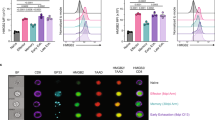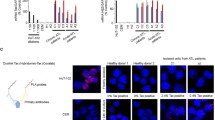Abstract
Adult T-cell leukemia/lymphoma (ATLL) is a malignancy slowly emerging from human T-cell leukemia virus type 1 (HTLV-I)-infected mature CD4+ T-cells. To characterize the molecular modifications induced by HTLV-I infection, we compared HTLV-I-infected WE17/10 cells with control cells, using micro-arrays. Many calcium-related genes were progressively downmodulated over a period of 2 years. Infected cells acquired a profound decrease of intracellular calcium levels in response to ionomycin, timely correlated with decreased CD7 expression. Focusing on apoptosis-related genes and their relationship with CD7, we observed an underexpression of most antiapoptotic genes. Western blotting revealed increasing Akt and Bad phosphorylation, timely correlated with CD7 loss. This was shown to be phosphatidylinositol 3-kinase (PI3K)-dependent. Activation of PI3K/Akt induced resistance to the apoptotic effect of interleukin-2 deprivation. We thus propose the following model: HTLV-I infection induces a progressive decrease in CD3 genes expression, which eventually abrogates CD3 expression; loss of CD3 is known to perturb calcium transport. This perturbation correlates with loss of CD7 expression and induction of Akt and Bad phosphorylation via activation of PI3K. The activation of the Akt/Bad pathway generates a progressive resistance to apoptosis, at a time HTLV-I genes expression is silenced, thus avoiding immune surveillance. This could be a major event in the process of the malignant transformation into ATLL.
This is a preview of subscription content, access via your institution
Access options
Subscribe to this journal
Receive 12 print issues and online access
$259.00 per year
only $21.58 per issue
Buy this article
- Purchase on Springer Link
- Instant access to full article PDF
Prices may be subject to local taxes which are calculated during checkout







Similar content being viewed by others
References
Poiesz BJ, Ruscetti FW, Gazdar AF, Bunn PA, Minna JD, Gallo RC . Detection and isolation of type C retrovirus particles from fresh and cultured lymphocytes of a patient with cutaneous T-cell lymphoma. Proc Natl Acad Sci USA 1980; 77: 7415–7419.
Yoshida M, Miyoshi I, Hinuma Y . Isolation and characterization of retrovirus from cell lines of human adult T-cell leukemia and its implication in the disease. Proc Natl Acad Sci USA 1982; 79: 2031–2035.
Yamada Y . Phenotypic and functional analysis of leukemic cells from 16 patients with adult T-cell leukemia/lymphoma. Blood 1983; 61: 192–199.
Kikuchi M, Mitsui T, Takeshita M, Okamura H, Naitoh H, Eimoto T . Virus associated ATLL in Japan: clinical, histological and immunological studies. Hematol Oncol 1986; 4: 67–81.
Yoshida M . Expression of the HTLV-1 genome and its association with a unique T-cell malignancy. Biochim Biophys Acta 1987; 907: 145–161.
Tsuda H, Takatsuki K . Specific decrease in T3 antigen density in adult T-cell leukaemia cells: I. Flow microfluorometric analysis. Br J Cancer 1984; 50: 843–845.
Morimoto C, Matsuyama T, Oshige C, Tanaka H, Hercend T, Reinherz EL et al. Functional and phenotypic studies of Japanese adult T cell leukemia cells. J Clin Invest 1985; 75: 836–843.
Long H, Gaffney P, Mortari F, Miller JS . CD3 gamma, CD3 delta, and CD3 zeta mRNA in adult human marrow hematopoietic progenitors correlates with surface CD2 and CD7 expression. Exp Hematol 1996; 24: 1402–1408.
Dahmoush L, Hijazi Y, Barnes E, Stetler-Stevenson M, Abati A . ATLL: a cytopathologic, immunocytochemical, and flow cytometric study. Cancer 2002; 96: 110–116.
Pace KE, Hahn HP, Pang M, Nguyen JT, Baum LG . CD7 delivers a pro-apoptotic signal during galectin-1-induced T cell death. J Immunol 2000; 165: 2331–2334.
Rappl G, Abken H, Muche JM, Sterry W, Tilgen W, Andre S et al. CD4+CD7- leukemic T cells from patients with Sezary syndrome are protected from galectin-1-triggered T cell death. Leukemia 2002; 16: 840–845.
Xu Q, Simpson SE, Scialla TJ, Bagg A, Carroll M . Survival of acute myeloid leukemia cells requires PI3 kinase activation. Blood 2003; 102: 972–980.
Lee DM, Patel DD, Pendergast AM, Haynes BF . Functional association of CD7 with phosphatidylinositol 3-kinase: interaction via a YEDM motif. Int Immunol 1996; 8: 1195–1203.
Sato AI, Balamuth FB, Ugen KE, Williams WV, Weiner DB . Identification of CD7 glycoprotein as an accessory molecule in HIV-1-mediated syncytium formation and cellfree infection. J Immunol 1994; 152: 5142–5152.
Wallace DL, Matear PM, Davies DC, Hicks R, Lebosse C, Eyeson J et al. CD7 expression distinguishes subsets of CD4(+) T cells with distinct functional properties and ability to support replication of HIV-1. Eur J Immunol 2000; 30: 577–585.
Badran BM, Wolinsky SM, Burny A, Willard-Gallo KE . Identification of three NFAT binding motifs in the 5′-upstream region of the human CD3gamma gene that differentially bind NFATc1, NFATc2, and NF-kappa B p50. J Biol Chem 2002; 277: 47136–47148.
Badran BM, Kunstman K, Stanton J, Moschitta M, Zerghe A, Akl H et al. Transcriptional regulation of the Human CD3g Gene: the TATA-less CD3 g promoter functions via an initiator and contiguous Sp-binding elements. J Immunol 2005; 174: 6238–6249.
Crabtree GR, Olson EN . NFAT signaling. Choreographing the social lives of cells. Cell 2002; 109 (Suppl): S67–S79.
Hogan PG, Chen L, Nardone J, Rao A . Transcriptional regulation by calcium, calcineurin, and NFAT. Genes Dev 2003; 17: 2205–2232.
Feske S, Okamura H, Hogan PG, Rao A . Ca2+/calcineurin signalling in cells of the immune system. Biochem Biophys Res Commun 2003; 311: 1117–1132.
Ware RE, Haynes BF . T cell CD7 mRNA expression is regulated by both transcriptional and post-transcriptional mechanisms. Int Immunol 1993; 5: 179–187.
Ware RE, Hart MK, Haynes BF . Induction of T cell CD7 gene transcription by nonmitogenic ionomycin-induced transmembrane calcium flux. J Immunol 1991; 147: 2787–2794.
Ledbetter JA, June CH, Grosmaire LS, Rabinovitch PS . Crosslinking of surface antigens causes mobilization of intracellular ionized calcium in T lymphocytes. Proc Natl Acad Sci USA 1987; 84: 1384–1388.
Coffer PJ, Woodgett JR . Molecular cloning and characterisation of a novel putative protein-serine kinase related to the cAMP-dependent and protein kinase C families. Eur J Biochem 1991; 201: 475–481.
Willard-Gallo KE, Van de Keere F, Kettmann R . A specific defect in CD3 gamma-chain gene transcription results in loss of T-cell receptor/CD3 expression late after human immunodeficiency virus infection of a CD4+ T-cell line. Proc Natl Acad Sci USA 1990; 87: 6713–6717.
Miyoshi I, Kubonishi I, Yoshimoto S, Akagi T, Ohtsuki Y, Shiraishi Y et al. Type C virus particles in a cord T-cell line derived by co-cultivating normal human cord leukocytes and human leukaemic T cells. Nature 1981; 294: 770–771.
Vandenberghe PA, Ceuppens JL . Flow cytometric measurement of cytoplasmic free calcium in human peripheral blood T lymphocytes with fluo-3, a new fluorescent calcium indicator. J Immunol Methods 1990; 127: 197–205.
Irizarry RA, Hobbs B, Collin F, Beazer-Barclay YD, Antonellis KJ, Scherf U et al. Exploration, normalization, and summaries of high density oligonucleotide array probe level data. Biostatistics 2003; 4: 249–264.
Kennedy RE, Kerns RT, Kong X, Archer KJ, Miles MF . SScore: an R package for detecting differential gene expression without gene expression summaries. Bioinformatics 2006; 22: 1272–1274.
Le Deist F, Thoenes G, Corado J, Lisowska-Grospierre B, Fischer A . Immunodeficiency with low expression of the T cell receptor/CD3 complex. Effect on T lymphocyte activation. Eur J Immunol 1991; 21: 1641–1647.
Stillman BN, Hsu DK, Pang M, Brewer CF, Johnson P, Liu FT et al. Galectin-3 and galectin-1 bind distinct cell surface glycoprotein receptors to induce T cell death. J Immunol 2006; 176: 778–789.
Lee DM, Patel DD, Pendergast AM, Haynes BF . Functional association of CD7 with phosphatidylinositol 3-kinase: interaction via a YEDM motif. Int Immunol 1996; 8: 1195–1203.
Liu Y, Wang Y, Yamakuchi M, Masuda S, Tokioka T, Yamaoka S et al Phosphoinositide-3 kinase-PKB/Akt pathway activation is involved in fibroblast Rat-1 transformation by human T-cell leukemia virus type I tax. Oncogene 2001; 20: 2514–2526.
Del PL, Gonzalez-Garcia M, Page C, Herrera R, Nunez G . Interleukin-3-induced phosphorylation of BAD through the protein kinase Akt. Science 1997; 278: 687–689.
Datta SR, Dudek H, Tao X, Masters S, Fu H, Gotoh Y et al Akt phosphorylation of BAD couples survival signals to the cell-intrinsic death machinery. Cell 1997; 91: 231–241.
Sheridan AM, Force T, Yoon HJ, O'Leary E, Choukroun G, Taheri MR et al. PLIP, a novel splice variant of Tip60, interacts with group IV cytosolic phospholipase A (2), induces apoptosis, and potentiates prostaglandin production. Mol Cell Biol 2001; 21: 4470–4481.
Boehning D, Patterson RL, Sedaghat L, Glebova NO, Kurosaki T, Snyder SH . Cytochrome C binds to inositol (1, 4, 5) trisphosphate receptors, amplifying calcium-dependent apoptosis. Nat Cell Biol 2003; 5: 1051–1061.
Xu S, Furukawa T, Kanai N, Sunamura M, Horii A . Abrogation of DUSP6 by hypermethylation in human pancreatic cancer. J Hum Genet 2005; 50: 159–167.
Acknowledgements
We thank the Belgian Fonds National de la Recherche Scientifique (FNRS, FRSM and Télévie), the Fonds Medic, the Friends of the Bordet Institute, the Belgian Foundation against Cancer for their support and Pr E Sariban for helping us to perform the calcium experiments in his laboratory. H Akl is a scientific collaborator of the FNRS-Télévie. We also thank B Haibe-Kaimo, Dr A Van den Broeke, R Rouas and L Lagneaux for their precious advices.
Author information
Authors and Affiliations
Corresponding author
Additional information
Supplementary Information accompanies the paper on the Leukemia website (http://www.nature.com/leu)
Supplementary information
Rights and permissions
About this article
Cite this article
Akl, H., Badran, B., Zein, N. et al. HTLV-I infection of WE17/10 CD4+ cell line leads to progressive alteration of Ca2+ influx that eventually results in loss of CD7 expression and activation of an antiapoptotic pathway involving AKT and BAD which paves the way for malignant transformation. Leukemia 21, 788–796 (2007). https://doi.org/10.1038/sj.leu.2404585
Received:
Revised:
Accepted:
Published:
Issue Date:
DOI: https://doi.org/10.1038/sj.leu.2404585
Keywords
This article is cited by
-
Proteome-wide characterization of signalling interactions in the hippocampal CA4/DG subfield of patients with Alzheimer’s disease
Scientific Reports (2015)
-
HTLV-1 and apoptosis: role in cellular transformation and recent advances in therapeutic approaches
Apoptosis (2008)
-
Progressive loss of CD3 expression after HTLV-I infection results from chromatin remodeling affecting all the CD3 genes and persists despite early viral genes silencing
Virology Journal (2007)



